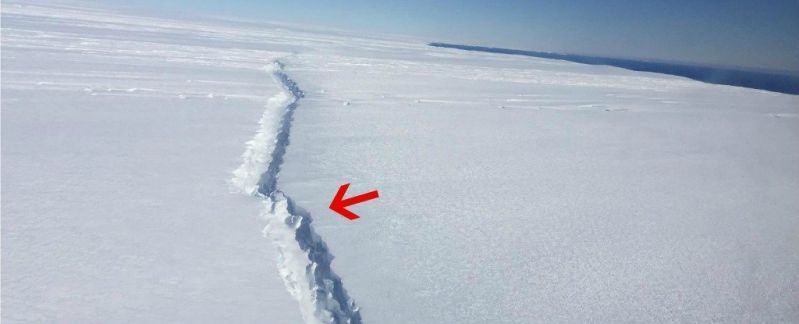The West Antarctic Ice Shelf is Breaking Apart from the Inside
Published on by Minja Ivanov, REC Bulgaria in Academic
Last year, a massive 583-square-kilometre chunk of the Pine Island Glacier - a vast section of ice that holds the West Antarctic ice sheet together - broke free, heading out into the ocean to eventually melt and raise sea levels across the world.

Now, new evidence from satellite imagery suggests that this break was caused by a rupture in the shelf 32 kilometres (20 miles) inland, indicating that the glacier is actually breaking apart from the inside, and not the periphery, as scientists had long suspected. And even worse - a second inland rift is now reportedly forming.
"Rifts usually form at the margins of an ice shelf, where the ice is thin and subject to shearing that rips it apart. However, this latest event in the Pine Island Glacier was due to a rift that originated from the centre of the ice shelf and propagated out to the margins," Howat explains.
"This implies that something weakened the centre of the ice shelf, with the most likely explanation being a crevasse melted out at the bedrock level by a warming ocean."
This hypothesis is backed up by the fact that Howat's team found that the rift opened up inside one of the sheet’s valleys.
These valleys, which are dips where parts of the ice sheet lie lower than sea level, allow warm water to reach further inland underneath it, causing indentations to form on the surface as ice melts below.
"The really troubling thing is that there are many of these valleys further up-glacier," Howat said. "If they are actually sites of weakness that are prone to rifting, we could potentially see more accelerated ice loss in Antarctica."
The team was able to come to their conclusions thanks to data collected by the Landsat 8 satellite - a joint project between NASA and the US Geological Survey, launched in 2013 to monitor changes on Earth’s surface.
Using this data, they were able to look for signs of the break that happened in 2015 - before the event occurred - coming across the rift formation in the process.
The team’s discovery is crucial to our understanding of how the world’s ice sheets are melting as our planet gets warmer and warmer.
According to the team, about half of the world’s fresh water is locked in Antarctica and the Pine Island Glacier.
Along with its 'twin' - the Thwaites Glacier - these two glaciers are vital to keeping all this water trapped, because they block ice streams from the outer ocean.
This means that if both - or really, just one - gives way, a bunch of that trapped ice will drift out into warmer ocean waters where it will melt.
You can picture this by imagining a cup of water with a big ice cube on top of it - big enough to touch the water inside but too large to actually fit inside the glass’s rim.
If this ice should melt, the water it releases will enter the glass, causing the water level to rise. This process happens a whole lot faster if the ice is broken up before it drops down, helping it to melt even quicker.
In real life, if that Antarctic 'ice cube' melts into our oceans, sea levels would rise an expected 3 metres (10 feet) across the globe, endangering many coastal cities like New York and Miami.
"We need to understand exactly how these valleys and rifts form, and what they mean for ice shelf stability," Howat explains. "We're limited in what information we can get from space, so this will mean targeting air and field campaigns to collect more detailed observations."
If the melting of the West Antarctic ice sheet really is an inevitability, we'll just have to hope that we can manage the consequences for life on Earth.
The team’s work was published in Geophysical Research Letters.
Source: Science Alert
Media
Taxonomy
- Environment
- Climate Change
- Climate Change Adaptation
- Climate Change
- Climate